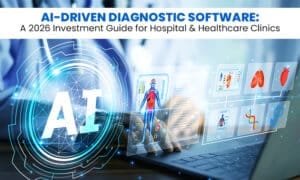
It’s a busy Tuesday morning at your local hospital. The A&E department is bustling with patients, nurses are rushing between wards, and doctors are trying to access patient records whilst juggling multiple cases. Now imagine if all this chaos could be streamlined with just a few clicks. That’s exactly what a Hospital Management System does – it’s like having a super-efficient digital assistant that never sleeps, never gets tired, and never loses important paperwork.
In today’s NHS, where staff shortages and increasing patient demands are constant challenges, hospitals are turning to technology to bridge the gap. A Hospital Management System isn’t just fancy software – it’s a game-changer that’s revolutionising how healthcare facilities operate. From reducing waiting times to preventing medical errors, these systems are quietly working behind the scenes to make hospitals run like well-oiled machines. Research shows that hospitals using integrated management systems can reduce administrative tasks by up to 30% and improve patient satisfaction scores significantly. Let’s explore seven brilliant ways these systems are transforming hospital workflows and making life easier for everyone involved.
1. Structured Patient Registration and Admission
- Reduces patient waiting times by up to 40%
- Eliminates duplicate paperwork and data entry errors
- Creates instant digital patient profiles
- Enables quick insurance verification
- Provides real-time bed availability updates
Gone are the days when patients had to fill out endless forms with a biro whilst perched on an uncomfortable plastic chair. A Hospital Management System transforms the entire admission process into a smooth, digital experience. When patients arrive, reception staff can quickly access their medical history, insurance details, and previous visits with just a few keystrokes.
The system automatically checks for available beds, calculates estimated waiting times, and even sends updates to patients’ mobiles. This means less time spent in queues and more time focusing on actual healthcare. For hospitals, this translates to better resource allocation and happier patients who aren’t left wondering when they’ll be seen. The digital registration also ensures that vital information like allergies or current medications is immediately visible to all healthcare staff, reducing the risk of dangerous oversights.
2. Enhanced Electronic Health Records (EHR) Management
- Instant access to complete patient medical histories
- Real-time updates across all departments
- Secure sharing between healthcare providers
- Automatic backup and data recovery
- Integration with diagnostic equipment and lab results
Remember when doctors had to hunt through filing cabinets for patient notes, often discovering that crucial files had gone missing? Those days are thankfully behind us. A Hospital Management System creates comprehensive electronic health records that are accessible 24/7 from anywhere in the hospital.
When a patient arrives at A&E, doctors can instantly see their complete medical history, current medications, previous surgeries, and even notes from their GP. This immediate access to information means faster diagnoses, better treatment decisions, and fewer medical errors. The system also ensures that when a patient sees a consultant on Tuesday and a physiotherapist on Thursday, both professionals have access to the same up-to-date information. It’s like having a complete medical biography of each patient that’s constantly being updated and is never misplaced.
3. Automated Appointment Scheduling and Management
- Online booking for patients and staff
- Automatic appointment reminders via text or email
- Real-time calendar synchronisation across departments
- Waitlist management for cancelled appointments
- Resource allocation based on appointment types
Coordinating appointments in a busy hospital used to be like playing three-dimensional chess blindfolded. A Hospital Management System turns this complex puzzle into a straightforward process. Patients can book appointments online, receive automatic reminders, and even reschedule if needed – all without picking up the phone.
The clever bit is how the system manages resources. It knows that Dr. Smith needs a specific examination room for cardiac procedures, that the MRI machine requires a 30-minute slot, and that certain appointments need follow-up bookings. When someone cancels last-minute, the system automatically offers that slot to patients on the waiting list. This intelligent scheduling reduces no-shows by up to 25% and ensures that expensive medical equipment and specialist staff time are used efficiently. It’s like having a super-organised personal assistant for the entire hospital.
4. Efficient Staff Scheduling and Resource Allocation
- Automated shift pattern creation
- Skills-based staff assignment
- Real-time availability tracking
- Holiday and sick leave integration
- Overtime and compliance monitoring
Managing hospital staff schedules is notoriously complex – you need the right mix of skills, experience levels, and specialist knowledge for each ward and shift. A Hospital Management System takes the headache out of this process by automatically creating optimal staff schedules based on patient needs, staff qualifications, and regulatory requirements.
The system knows that the intensive care unit needs a minimum ratio of qualified nurses to patients, that certain procedures require specific certifications, and that staff members have preferences for particular shifts. When someone calls in sick, the system immediately identifies qualified replacements and can even send automatic notifications to available staff. This means better patient care through appropriate staffing levels and happier employees who have more predictable and fair work schedules. Hospitals using automated scheduling report up to 20% reduction in overtime costs and improved staff satisfaction.
5. Managed Inventory and Supply Chain Management
- Real-time stock level monitoring
- Automatic reordering of essential supplies
- Expiry date tracking and alerts
- Usage pattern analysis
- Cost optimisation recommendations
Hospital supplies range from basic bandages to life-saving medications and expensive surgical equipment. Keeping track of everything manually is practically impossible, which is why a Hospital Management System includes comprehensive inventory management. The system monitors stock levels in real-time, automatically reorders items when supplies run low, and even tracks expiry dates to prevent waste.
The clever algorithms learn usage patterns – they know that the A&E department uses more sutures during weekend nights, that certain medications have seasonal demand, and which suppliers offer the best value for money. This predictive capability means hospitals rarely run out of critical supplies, reduce waste from expired products, and negotiate better deals with suppliers. Many hospitals report reducing their inventory costs by 15-20% whilst maintaining better stock availability. It’s like having a crystal ball that predicts exactly what supplies you’ll need and when.
6. Improved Communication and Collaboration
- Secure messaging between staff members
- Patient progress sharing across departments
- Integration with mobile devices and pagers
- Document sharing and collaboration features
- Emergency alert systems
Effective communication in hospitals can literally be a matter of life and death. A Hospital Management System creates a secure, instant communication network that connects everyone from consultants to porters. Instead of playing phone tag or leaving handwritten notes that might get lost, staff can send secure messages, share patient updates, and collaborate on treatment plans in real-time.
The system ensures that when a patient’s condition changes, all relevant staff are notified immediately. It can send priority alerts for emergencies, coordinate multi-disciplinary team meetings, and ensure that discharge planning involves all necessary departments. This improved communication reduces medical errors, speeds up decision-making, and ensures that patients receive coordinated care from their entire healthcare team. Studies show that hospitals with integrated communication systems experience 30% fewer communication-related errors.
7. Data Analytics and Performance Monitoring
- Patient flow and waiting time analysis
- Staff productivity and efficiency metrics
- Financial performance tracking
- Quality indicators and compliance reporting
- Predictive analytics for future planning
A Hospital Management System doesn’t just manage day-to-day operations – it also provides valuable insights that help hospitals improve continuously. The system collects data on everything from patient satisfaction scores to equipment utilisation rates, creating comprehensive dashboards that highlight trends and identify areas for improvement.
Hospital managers can see which departments have the longest waiting times, which procedures are most cost-effective, and when patient volumes typically peak. This information enables evidence-based decision making, whether it’s deciding when to schedule maintenance, how to allocate budgets, or where to focus improvement efforts. The predictive analytics can even forecast future demand, helping hospitals prepare for seasonal variations or demographic changes. It’s like having a team of data analysts working around the clock to optimise every aspect of hospital operations.

Conclusion
Hospital Management Systems are transforming healthcare delivery across the UK, making hospitals more efficient, safer, and more patient-friendly. From the moment patients book their appointments to their final discharge, these systems work quietly in the background, coordinating complex processes and ensuring that everything runs smoothly.
The seven areas we’ve explored – patient registration, health records, scheduling, staff management, inventory control, communication, and analytics – all work together to create a seamless healthcare experience. For patients, this means shorter waiting times, better coordinated care, and fewer administrative hassles. For hospital staff, it means less paperwork, better communication, and more time to focus on what matters most: providing excellent patient care.
As the NHS continues to face challenges with funding and staffing, Hospital Management Systems offer a practical solution that maximises efficiency whilst improving patient outcomes. The future of healthcare is digital, and these systems are leading the way.
References-
The Early History of Hospital Information Systems for Inpatient Care in the United States





